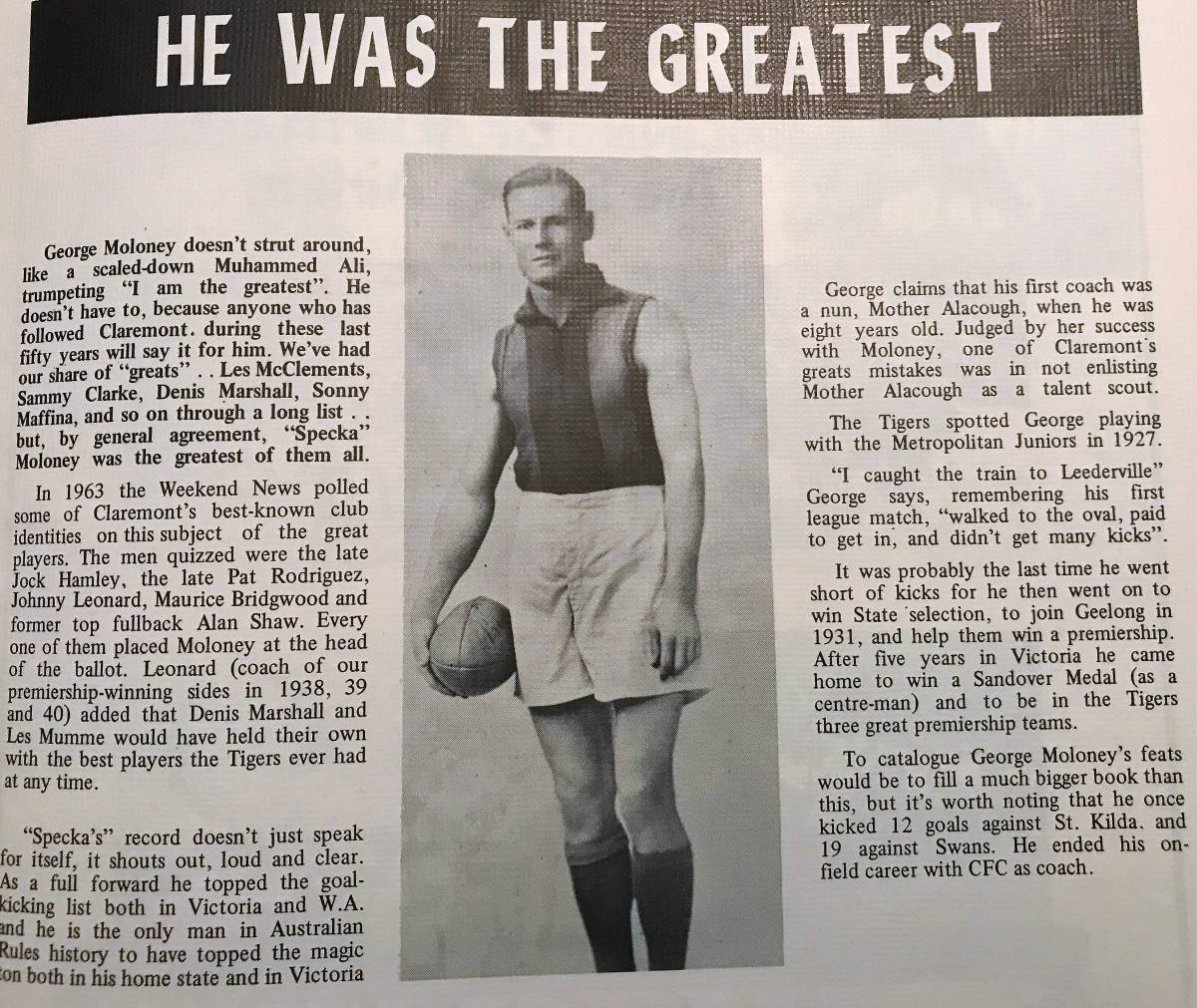
George Moloney in Articles and Photos detailing his career at Claremont and Sandover medal win 1936
Full name George Michael Moloney Nickname Specka
Born 7 August 1909 at East Fremantle, WA
Died 5 January 1983 (aged 73) at Nedlands
Senior clubs Claremont and Geelong
Recruited from Claremont 1931 and Geelong 1936
State of origin WA
Hall of fame Australian Football Hall of Fame (1996); Western Australian Football Hall Of Fame (2004) Legend
Claremont Played 190 games between 1927 – 1930 & 1936 – 1941, 1945 Scored 555 Goals
Geelong Played 88 Games between 1931 – 1935 scoring 303 Goals
Whereas in modern football versatility on the part of players is regarded almost as a pre-requisite, in days gone by it was very much the exception rather than the rule. The idiosyncrasies of each playing position were felt to be so distinctive and unique that the overwhelming majority of players tended to be specialists, concentrating on mastering a single position. A major reason for this was that, to a coach like Jock McHale or Jack Worrall, football tended to be perceived in terms of a multiplicity of individual contests – full back versus full forward, wingman versus wingman, and so forth – with a concomitant desirability for players to remain in position in order to facilitate such contests. In the eyes of Jock McHale, players who wandered out of position were committing football’s cardinal sin – and given that the game at the time was almost wholly centered on kicking, with handball being predominantly used defensively, such a view made eminent sense.
In this context, mastery by a single player of more than one position required immeasurably more versatility than would be the case nowadays. In a real sense, a full forward and a centreman were playing different games, and while the same player might make a decent stab at playing both positions, it was rare indeed to find an individual capable of mastering both, of being both a champion full forward and a champion centreman.
One such individual was George “Specka” Moloney who, two games from the end of the 1927 season, made his WAFL debut with Claremont-Cottesloe, which was playing in only its second league season. In return for this privilege, Moloney had to pay 10 shillings club membership, make his own way to the ground on public transport, and pay an admission charge at the turnstiles. His match fee? Nothing more nor less than the warm glow of inner satisfaction gleaned from participating in top level football, coupled with multifarious bumps, bruises and cuts courtesy of the opposition.
Given such incentives, what could George Moloney possibly do but come back for more? The following week, in a sign of things to come, he was best afield, thereby securing a place in the team for 1928, and the longer that 1928 season went on, the clearer it became that Claremont-Cottesloe had unearthed a future champion. Playing mainly at full forward, he was quick, elusive, strong overhead (despite being only 174 cm in height), and a deadly kick for goal, whether from a set shot, or in open play, with some of his snap shots being of the jaw-droppingly spectacular kind. Moloney topped the club’s goal kicking list in 1928 with 56 goals, and the following season saw him lift his performance level still further. On 10 August 1929 he made his interstate debut for Western Australia at Perth Oval and booted three goals in a five-point win over South Australia. He went on to top Claremont-Cottesloe’s goal kicking once more, this time with 61 goals, and the following year did better still, booting 78 goals for his club, and starring, with 19 goals in five games, for Western Australia at the Adelaide carnival.
Moloney’s prowess in Adelaide did not go unnoticed as he was approached by officials from Geelong, who wanted him to transfer to their club in 1931. Perhaps somewhat surprisingly, a clearance was granted with a minimum of fuss, and Moloney went on to become a highly important and influential player for Geelong in 88 games over five seasons. During his last VFL year, coach Percy Parratt, whether on a hunch or because he had spotted something significant in Moloney’s style of play, ventured the apparently audacious experiment of playing him as a centreman rather than at the goal-front, and he proved a revelation. Returning home to Claremont¹ in 1936, he continued in the centre with devastating effect, winning both the Sandover Medal and club fairest and best award. Moreover, Claremont enjoyed easily their best league season to date, not only qualifying for the finals for the first time, but actually making it to the Grand Final before losing narrowly to East Perth.
George Moloney carried on at Claremont until 1945 (with a break for the war between 1942 and 1944), reverting to his former position of full forward in 1939, and kicking more than a century of goals in 1940 and 1941. He was a key player, and captain, in Claremont’s ground-breaking premiership wins of 1938, 1939, and 1940. All told, he played a total of 190 WA(N)FL games, some of them alongside brothers Robert (103 games 1930-36) and Syd (145 games 1934-41).
Arguably the greatest name in the history of the Claremont Football Club, and certainly one of the most uniquely versatile champions ever to have adorned the game, George “Specka” Moloney rounded off his association with the Tigers by coaching them, sadly without success, from 1948 to 1951.
Author – John Devaney

